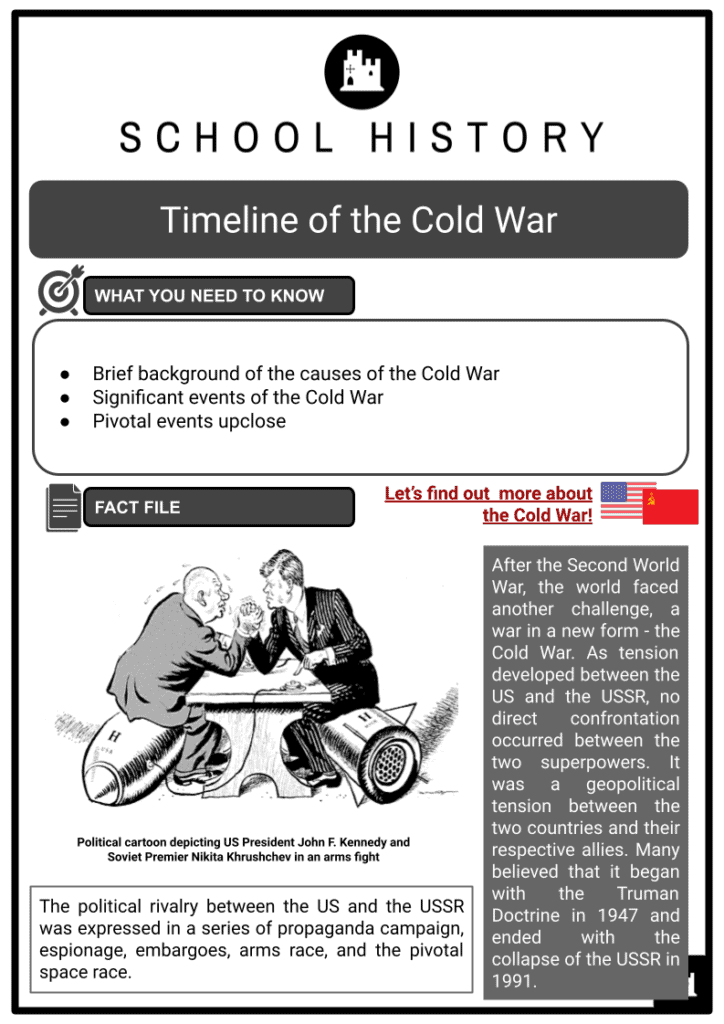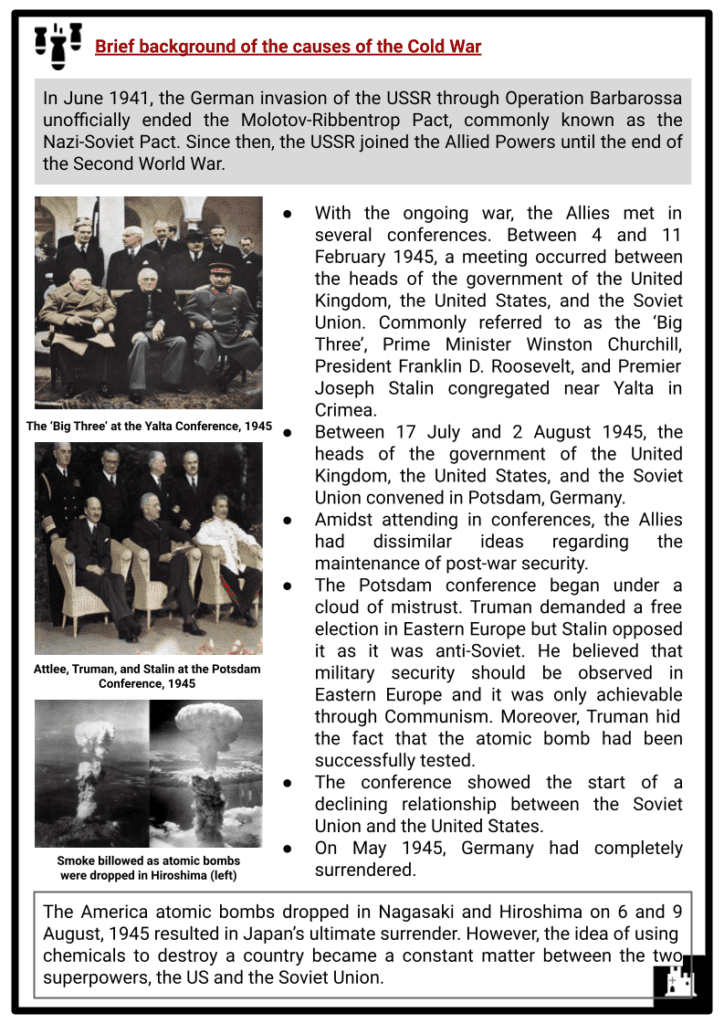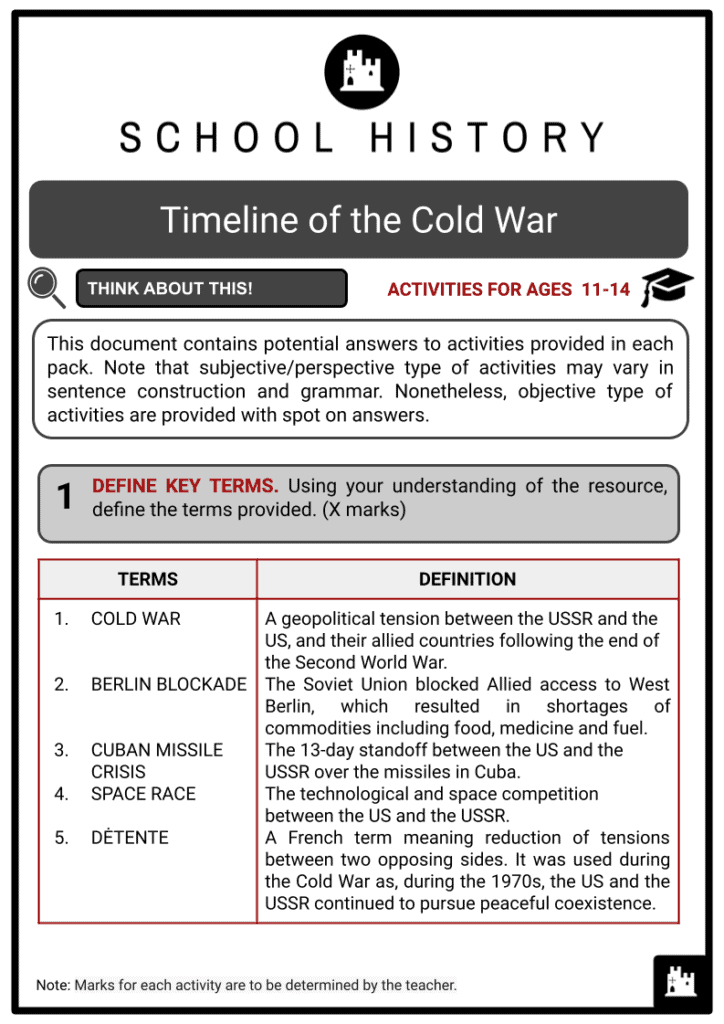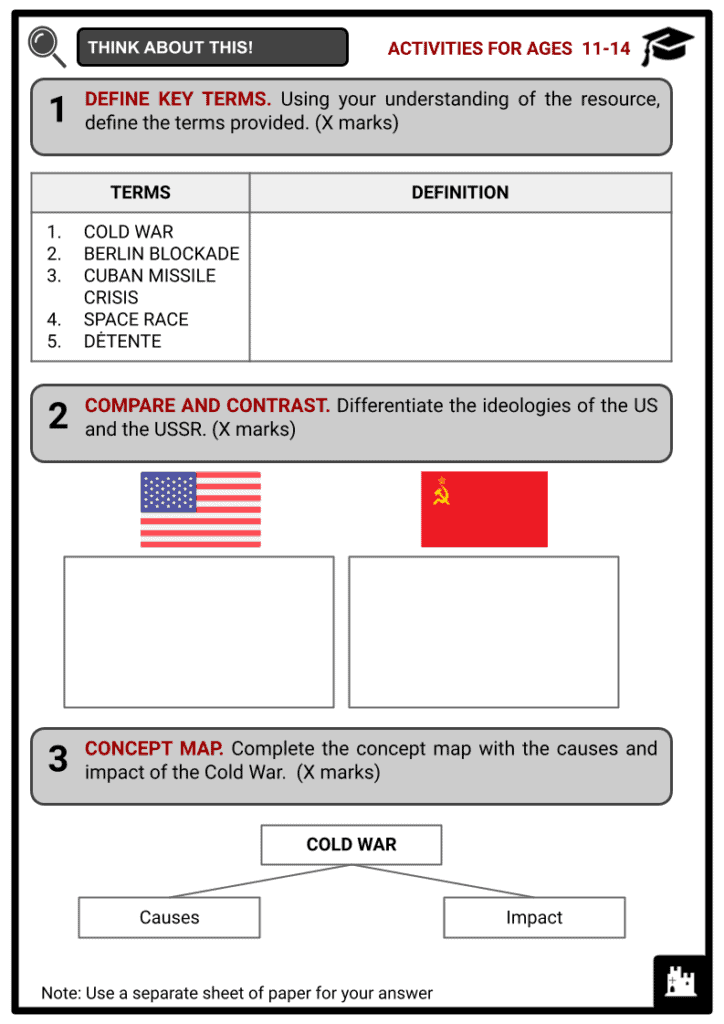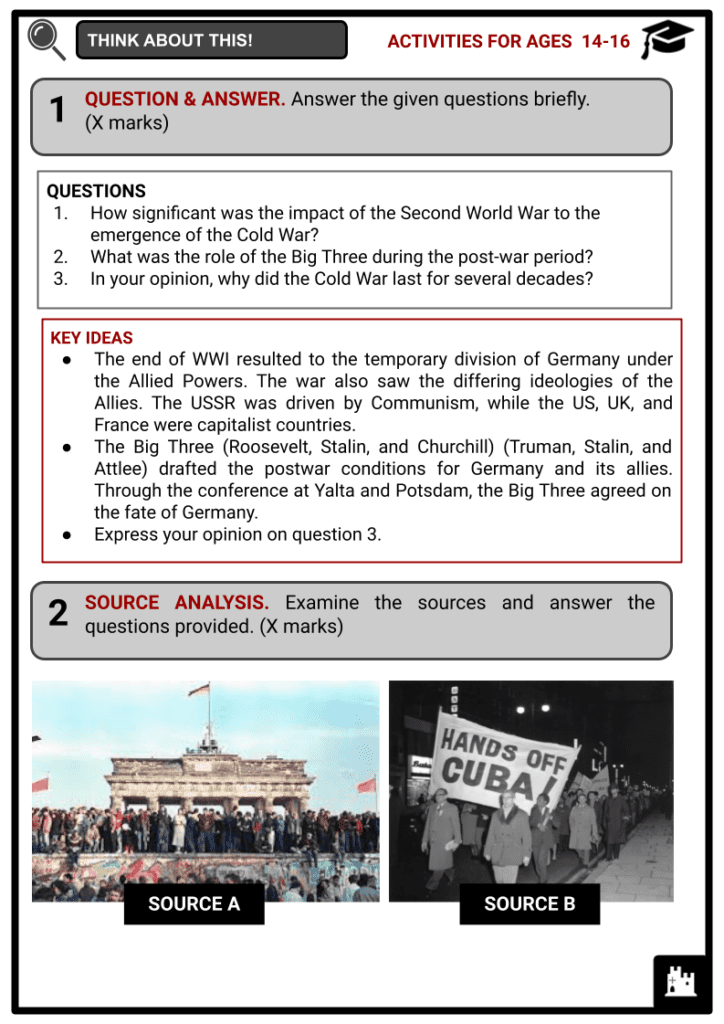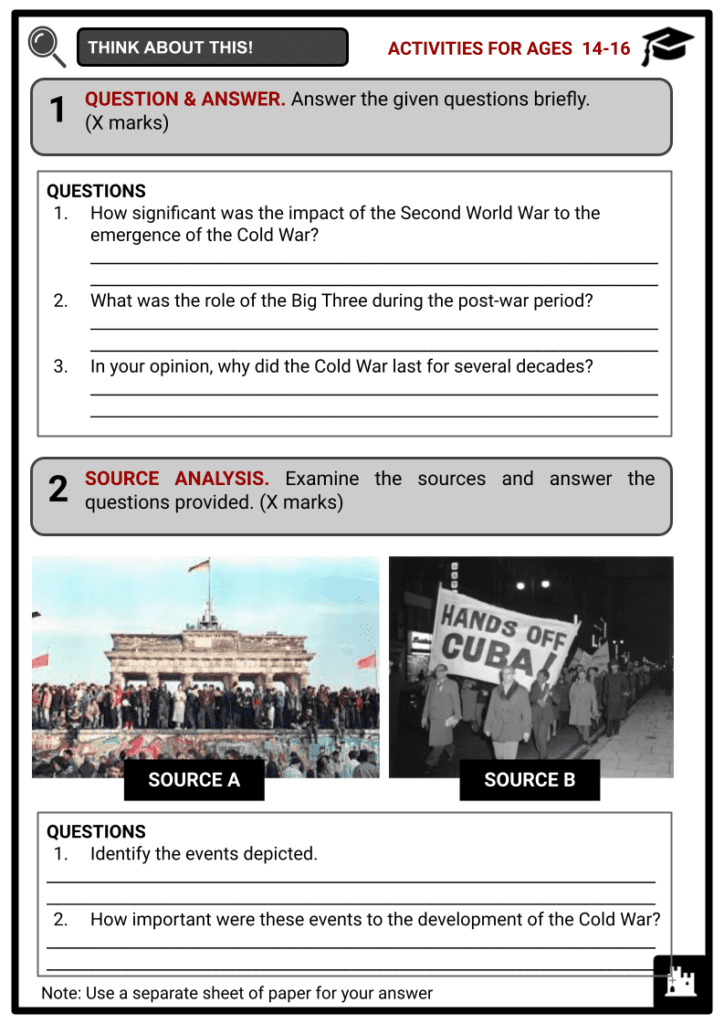Download Timeline of the Cold War
Do you want to save dozens of hours in time? Get your evenings and weekends back? Be able to teach the Timeline of the Cold War to your students?
Our worksheet bundle includes a fact file and printable worksheets and student activities. Perfect for both the classroom and homeschooling!
Table of Contents
Add a header to begin generating the table of contents
Summary
- Brief background of the causes of the Cold War
- Significant events of the Cold War
- Pivotal events up close
Key Facts And Information
Let’s find out more about the Cold War!
- After the Second World War, the world faced another challenge, a war in a new form - the Cold War. As tension developed between the US and the USSR, no direct confrontation occurred between the two superpowers. It was a geopolitical tension between the two countries and their respective allies. Many believed that it began with the Truman Doctrine in 1947 and ended with the collapse of the USSR in 1991.
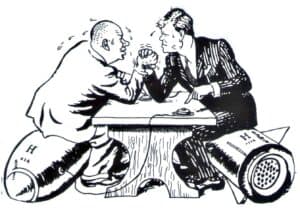
Significant events of the Cold War
- 1945
- 6 & 9 August. Atomic bombs were dropped on Nagasaki and Hiroshima which advanced the US in terms of warfare.
- 1947
- 5 June. Under the Marshall Plan, the US provided financial aid to countries in Europe. Joseph Stalin refused to accept.
- 1948
- 24 June. Tensions between Eastern and Western Germany resulted to the beginning of the Berlin Blockade.
- 1949
- 4 April. The North Atlantic treaty Organization or NATO was established. Its main purpose was to deter Soviet expansionism in Eastern Europe.
- 29 August. Code-named ‘RDS-1’, the USSR launched its first nuclear test in a test site in Kazakhstan.
- 1 October. Communist leader Mao Zedong declared the creation of the People’s Republic of China.
- 1950
- 25 June. The Korean War began.
- 1952
- 1 November. Under President Harry Truman, the US successfully detonated its first hydrogen bomb named ‘Mike’ on the Eniwetok Atoll located in the Marshall Islands.
- 1953
- 5 March. Secretary-general of the Communist Party of the Soviet Union and premier of the Soviet state, Joseph Stalin died.
- 27 July. Following the Korean Armistice Agreement, the Korean War ended. South and North Korea came up with a compromise after the nuclear threat of newly elected US President Dwight Eisenhower
- 12 August. The USSR detonated its first hydrogen bomb in northern Kazakhstan.
- 1955
- 14 May. The Warsaw Pact was created by the Soviet Union and seven of its satellites in Europe.
- 1956
- 23 October. The Hungarian Revolution/Uprising began. It was a nationwide uprising against the Soviet-controlled Hungarian People’s Republic.
- 29 October. Also known as the Second Arab-Israeli War, the Suez Crisis was an Israeli led invasion of Egypt. Israel was supported by France and the UK.
- 1957
- 4 October. The Soviet Union began the Space Age with the successful launching of Sputnik, the first artificial satellite sent to space.
- 1959
- 16 February. Fidel Castro sworn as prime minister of Cuba after leading a coup against Cuban leader Fulgencio Batista.
- 1961
- 13 May. US President John F. Kennedy sent the first American troops to Vietnam to aid the government of President Ngo Dinh Diem.
- 25 May. Alarmed with the Soviet space program, JFK delivered a speech before Congress regarding the moon mission.
- 13 August. The German Democratic republic began the building of the Berlin Wall.
- 1962
- 16 May. The 13-day political and military standoff between the US and USSR over Cuba began. This became known as the Cuban Missile Crisis.
- 1965
- 8 May. The US announced its open involvement in the Vietnam War. The initiative was made by US President Lyndon B. Johnson.
- 1967
- 5 June. Also known as the June War, the Six-Day War was an armed conflict fought between Israel and the Arab coalition of Jordan, Syria, and Egypt.
- 1968
- 20 August. Under Operation Danube, a joint invasion of Czechoslovakia by the Soviet Union, Bulgaria, Hungary, and Poland took place.
- 1973
- 6 October. Also known as the October War or the Ramadan War, the Yom Kippur War was the Fourth Arab-Israeli War fought between Israel and the coalition of Arab states - majority of Egypt and Syria.
- 1979
- 24 December. Following the 1978 Afghan coup, the Soviet Union invaded Afghanistan. Soviet leader Leonid Brezhnev ordered the assault.
- 1986
- 11 October. US President Ronald Reagan and Soviet leader Mikhail Gorbachev met in Iceland for the Reykjavik Summit. Despite having no significant agreement, it led to the eventual Intermediate-Range Nuclear Forces Treaty.
- 1987
- 8 December. Reagan and Gorbachev signed the INF Treaty.
- 1989
- 9 November Fall of the Berlin Wall.
- 1990
- 29 May. Boris Yeltsin was elected President of Russia.
- 3 October. Germany reunified. The German Democratic Republic joined the Federal Republic of Germany.
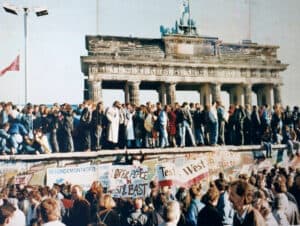
- 1991
- 1 July. The Warsaw Pact was dissolved.
- 25 December. USSR President Gorbachev resigned.
- 26 December. Following the independence of the satellite states, the Council of the Republics of the Supreme Soviet of the USSR officially dissolved the Soviet Union.
Pivotal Events up close
The atomic bomb
- As part of the US government’s Manhattan Project, the atomic bomb was used to force Japan into ultimate surrender. However, some historians also suggest that the US also used it as a warning to the Soviet Union as a show of strength of the American government.
- Around 140,000 people were killed in Hiroshima and 74,000 people in Nagasaki. Over the next five years, people died en masse from the effects of radiation.
Division of Germany
- After the Second World War, Germany was divided into four zones of occupation. As per the Yalta and Potsdam Conferences, the zones were placed under the control of the United States, the United Kingdom, France, and the Soviet Union.
- The Allied powers divided Germany into four military occupation zones: Great Britain in the northwest, the Soviet Union in the east, the United States in the south, and France in the southwest. They exercised sovereign powers over these zones, which were treated as one country as per their 1937 territorial rights prior to Nazi expansion.
- Eastwards, the Soviet Union and Poland were given control as per the Oder-Neisse line. It bordered Germany from Poland as the line ran along the Oder and Lusatian Neisse rivers.
- Following the division, the US and Great Britain formed the Bizonia. Bizonia was the combined economic unit that was established to revive the German economy in American and British zones.
- As part of Bizonia, the Deutschmark (a new currency) was introduced. Stalin, however, saw these developments differently to the US and Britain.
- Stalin began breaking agreements made at Yalta because he believed that both Attlee and Truman were weaker leaders.
- Armed with his ambition to spread Communism, Stalin broke the Declaration of Liberated Europe. While other Allied countries encouraged and allowed free trade in Germany, Stalin closed the Russian-controlled zone to trade.
Crisis in Berlin
- By February 1948, the British, French, and American governments began to merge their zones economically to unify them and form a national government. In response, the Soviet Union imposed a blockade of Berlin to halt the process of unifying West Germany and to secure the Soviet-controlled territory in the eastern zone.
- The Berlin Blockade lasted for almost 20 days and became one of the major crises during the Cold War. The Soviet Union blocked Allied access to West Berlin, which resulted in shortages of commodities including food, medicine and fuel.
- Over the next 321 days, starting on June 24, 1948, the Allies airlifted supplies into Berlin using 275,000 flights to deliver 4,000 tons of supplies each day.
Formation of the Comecon, NATO, and Warsaw Pact
- On 5 January 1949, Joseph Stalin forbade Soviet satellite countries from accepting US aid. He initiated the creation of the Council for Mutual Economic Assistance (COMECON). Its aim was the promotion of economic cooperation through free trade among the member countries, including the Soviet Union, Bulgaria, Czechoslovakia, Hungary, Poland, and Romania. By 1950, the German Democratic Republic became a member, followed by the Mongolian People’s Republic in 1962. Others included Cuba (1972) and Vietnam (1978).
- British Foreign secretary Ernest Bevin was the man behind the idea of creating NATO. Initially, the Western Union was formed in March 1948 and comprised of Britain, France, Belgium, the Netherlands, and Luxembourg.
- In 1950, Dwight D. Eisenhower became the Supreme Commander of NATO as appointed by President Harry S. Truman. Some scholars believe that the creation of NATO featured among the tensions that heightened the Cold War as NATO members prematurely reacted to possible Soviet aggression.
- In 1955, when West Germany was added as a NATO member, it allowed for remilitarisation, which was viewed as a threat by the Soviets. In response, the Soviet Union, along with its satellite states, created the Warsaw Pact, a military alliance officially known as the Treaty of Friendship, Cooperation and Mutual Assistance.
- The Warsaw Pact was directly governed by Moscow, which sought to exercise tighter control over satellite states. Its main focus was to establish coordinated defence among its members and enhance its military capability to deter any internal and external attacks.
The Space race: Sputnik and Apollo missions
- Sputnik I was the world’s first artificial satellite. The Soviet success marked the beginning of the space age between the US and the USSR. A few years later, JFK announced the American moon landing mission.
- However, on 12 April 1961, the USSR achieved another space milestone when cosmonaut Yuri Gagarin became the first man to orbit Earth.
- JFK did not witness the completion of his ambition. On 20 July 1969, the Apollo mission landed on the moon.
The nuclear arms race in the 1950s
- The nuclear arms race in the 1950s showed the competition for superiority between world superpowers, particularly the US and the USSR. The development of nuclear weapons cost both countries enormous resources.
- Acquisition of nuclear weapons became a form of deterrence for another world war. However, the increase of arms stock also led to several conflicts during the early years of the Cold War. For example, Soviet nuclear threats created a crisis in the Suez Canal and Cuba.
- In addition to monetary resources, the nuclear arms race created anxiety for both the Soviet and American populations.
- The arms race also led other nations, including Great Britain, France, and the People’s Republic of China to build and stockpile their own nuclear weapons. By 1953, the Soviets were testing their own thermonuclear bombs and expanded their research over the coming decade.
The Berlin Wall, the Cuban Missile Crisis, and the events in Czechoslovakia
- A number of East Germans sought to escape poverty-stricken East Germany (GDR). They wanted to flee to West Germany as it was described as being prosperous due to Western control. Nikita Khrushchev demanded the West leave Berlin, but they refused.
- In response to the migration to West Germany, on 13 August 1961, the GDR constructed a barbed wire fence along the border of East and West Berlin. These wire barriers were later replaced by a concrete wall.
- In 1961, Soviet leader Nikita Khrushchev publicly announced that Berlin was part of East Germany. He also warned the West German government against taking military action. In response to the threat, the West German government decided to also build a wall that they called an “anti-fascist protective wall.” The USSR ordered the placement of fences, trenches, and watchtowers along the wall.
- In 1959, the Cuban dictator Fulgencio Batista was overthrown by Fidel Castro, a left-wing revolutionary. Castro established a totalitarian government supported by the Soviets.
- Tensions increased as the US had several investments in Cuba and was the major consumer of the country’s sugar and tobacco.
- The USSR offered their full support to Castro’s regime. Castro adapted communism in Cuba by nationalising all the private-owned companies, mostly American ones. As the country is located 90 miles south of Florida, the US felt threatened due to the USSR’s sphere of influence.
- The US imposed a trade embargo on Cuba, which meant Cuba lost its major consumer of sugar and tobacco. Furthermore, it stopped economic aid and banned Cuba from trading with them.
- In 1961, the US cut its ties with Cuba. Castro then sought support from the USSR, which they obliged by supplying oil, weapons, and other goods to Cuba.
- On 17 April 1961, a CIA paramilitary group made up primarily of Cuban exiles intending to remove Castro from power, landed in the Bay of Pigs in Cuba. The invasion failed as 20,000 soldiers of the Cuban Revolutionary Armed Forces defeated them in three days.
- The fallout from the failed invasion left the US feeling humiliated while the increased threat felt by Cuba saw it seek greater support from the USSR. In July 1962, Khrushchev and Castro had a secret meeting in which it was agreed that several missile launch facilities would be placed in Cuba to deter US aggression. By July 1962, the Cuban army was heavily equipped.
- On 22 October 1962, US intelligence discovered that a Soviet fleet carrying more missiles was heading to Cuba from Turkey. The US dispatched warships in the Atlantic to prevent its arrival.
- By 26 October, Khrushchev sent a conciliatory letter to Kennedy agreeing to stop the Soviet fleet if the US agreed to not invade Cuba and to remove its missiles in Turkey.
- On 28 October, Khrushchev announced through a public television address to Kennedy that the missiles in Cuba had been removed.
- After the Hungarian Uprising, Czechoslovakia remained under the control of the hardliner Stalinist leader, Antonín Novotný. In January 1968, Novotný was replaced by Alexander Dubček. Unlike Novotný, he supported the desire of the people by implementing “socialism with a human face”. This policy relaxed the restraints on freedom of speech and guaranteed the right to abode. Economic reforms were also implemented.
- The Czechs were highly satisfied with the reforms implemented by Dubček and a period of peace and stability emerged across the country. This period is known as the “Prague Spring”. However, despite the reforms implemented by Dubček, several Czechs still called for extreme political reforms such as the country’s withdrawal from the Soviet bloc.
- Due to the Hungarian Uprising and the Prague Spring Movement, the USSR adopted the Brezhnev Doctrine.
- The doctrine reiterated that limited independence would be given to the Soviet satellite states. Furthermore, no countries could leave the Warsaw Pact and no member states should disturb the ruling communist party. It remained in effect until 1989.
Towards Détente
- On 5 March 1953, Joseph Stalin died and was replaced by Georgy Malenkov. His objective was to improve relations with Western powers in order to shift the government’s expenditure to the people’s needs. By 1955, Malenkov was forced to resign due to abuse of power and was replaced by Nikita Khrushchev.
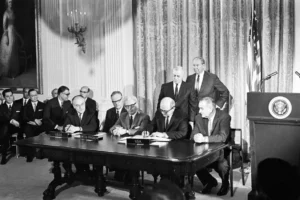
- Khrushchev wanted to ease the tension between the Soviets and the West. His government called for a policy of peaceful coexistence with the West. Furthermore, he called for the reduction of the size of the Soviet armed forces as well as military expenditure.
- On 30 August, 1963, both countries also agreed to the installation of a hotline which set up a direct link of communication between the US President in Washington and Russian Premier in Moscow.
- On 5 August 1963, the United States, the UK and the Soviet Union agreed to ban any testing of nuclear weapons in space, above the ground, and in the sea. However, underground testing was still permitted.
- On 10 October 1967, the treaty banned stationing of weapons of mass destruction in outer space, including any military activities related to space exploration. This treaty later provided the framework for international space law.
- On 1 July 1968, the US, USSR, and UK signed a treaty which limited the production and spread of any military nuclear technology by the known nuclear-weapon states to non-nuclear nations. However, countries were allowed to exchange peaceful nuclear technology. This multilateral treaty aimed to further pursue disarmament among nuclear-weapon states.
- Beginning in 1971, US President Richard Nixon and the Soviet Union’s Secretary General Leonid I. Brezhnev began to improve relations with one another, which became known as the period of dѐtente.
- Following American humiliation in the Vietnam War, President Nixon made efforts to improve relations with the USSR and China. In February 1972, he visited China and withdrew any objections to China joining the UN. In May of the same year, Nixon visited Moscow which resulted to the signing of SALT I.
- After 1972, it was followed by a series of talks between 1972-1979, known as SALT II. As Brezhnev and Nixon wanted to improve the relationship of the East and the West, the signing of the Helsinki Accords ratified an era of détente.
Collapse of the USSR
- In 1985, Mikhail Gorbachev rose to power as the new leader of the USSR and began to employ policies that aimed to restructure the Soviet economy and politics.
- By the time of Gorbachev’s succession, the USSR was in stagnation and isolated from the West. Under Gorbachev, the Red army withdrew from Afghanistan. Strategic Arms Reduction Talks (START) and the Intermediate-Range Nuclear Forces Treaty agreement with the US also began.
- In response to growing opposition in satellite states to the Soviet policies, Gorbachev ordered the withdrawal of the Red Army in the Eastern bloc and announced that Soviet puppet governments had come to an end.
- Unrests in Eastern Europe in the late 1980s and early 1990s gave way to the rise of the idea of nationalism and nationalist movements. Such movements among former Soviet satellite states led to the declaration of independence from the central authority in Moscow.

